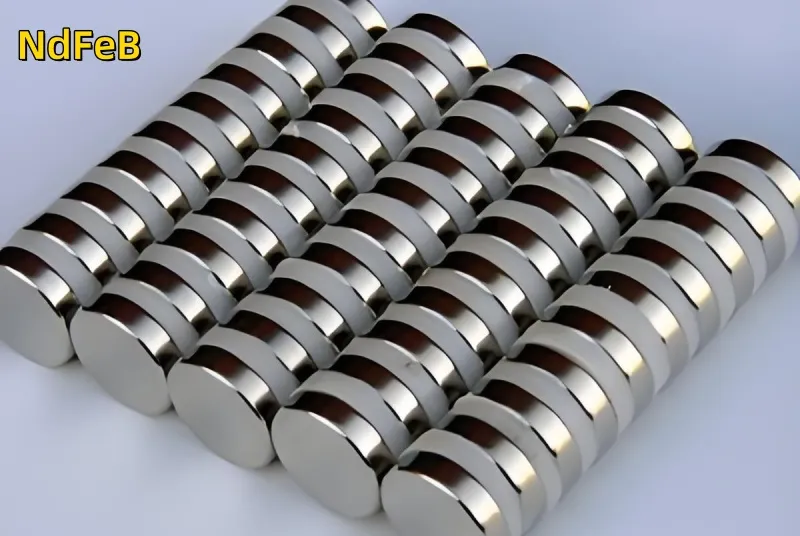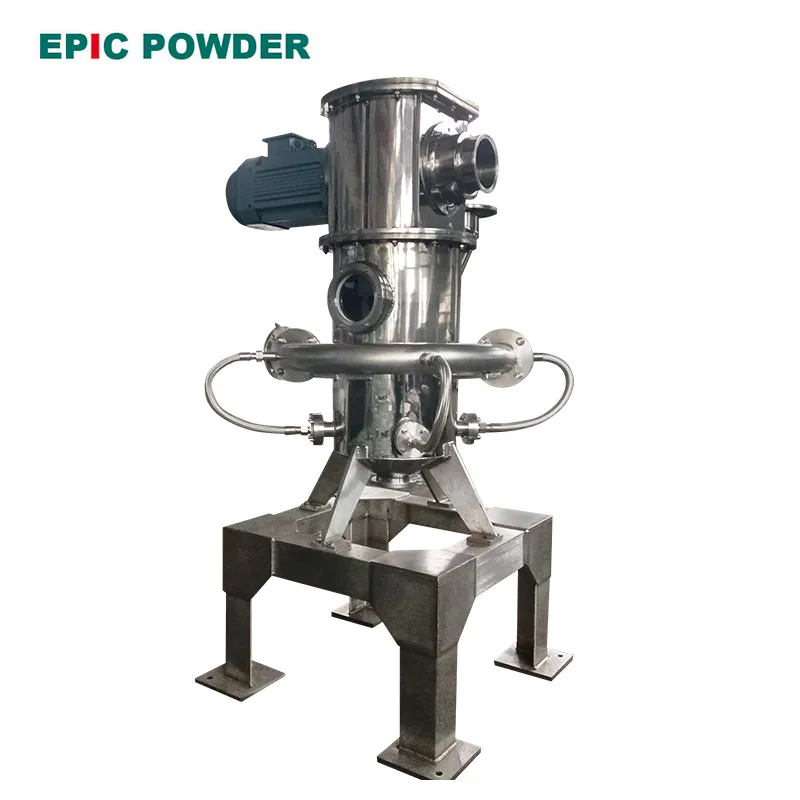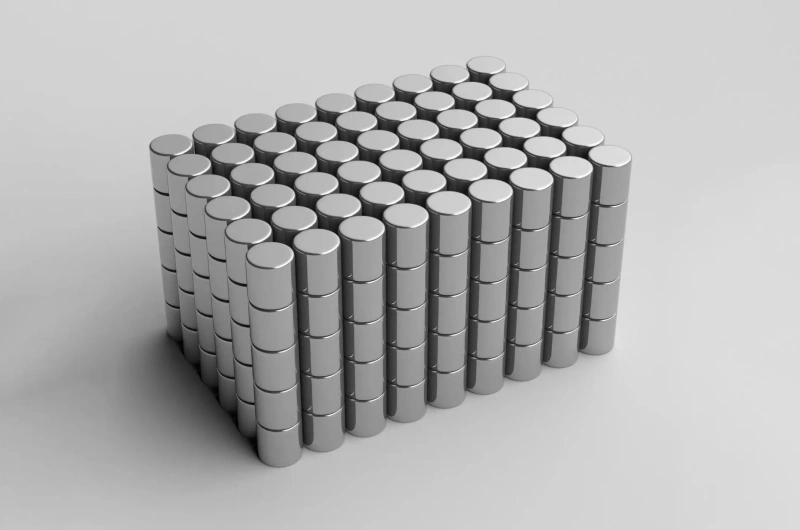Neodymium–iron–boron (Nd-Fe-B) is the most representative rare-earth permanent magnetic material. Its main composition includes neodymium (Nd), iron (Fe), and boron (B), where rare-earth elements account for about 25–35%, iron 65–75%, and boron around 1%. NdFeB is currently the permanent magnetic material with the highest magnetic energy product in the world and is known as the “King of Modern Permanent Magnets.” This also means that NdFeB materials can achieve the same magnetic flux with the smallest volume.
Сферы прымянення: Permanent magnet motors, medical devices, wind power, new-energy vehicles, etc.
According to manufacturing processes, NdFeB magnets can be divided into sintered, bonded, and hot-pressed types, among which sintered NdFeB is the most widely used.

Overview of the Manufacturing Process
Sintered NdFeB permanent magnets are essentially produced through powder metallurgy.
The key process flow includes:
Raw material mixing → Melting & strip casting → Hydrogen decrepitation → Струйное фрэзераванне → Orientation forming → Sintering & heat treatment → Mechanical machining → Surface treatment → Magnetization
Падрабязнае апісанне працэсу
Raw Material Pre-treatment and Mixing
Before batching, raw materials must be free of debris, oxides, and dust to minimize impurities.
According to the required magnet properties, the ratios of Nd, Fe, B and trace additives (such as Dy, Tb, Co, Al, etc.) are precisely calculated.
Melting / Strip Casting
Melting is carried out in a vacuum induction furnace at approximately 1460°C, allowing raw materials to melt into an alloy under inert gas protection.
The molten alloy is then cast onto a rapidly rotating copper chill roll, forming thin, uniformly thick rapidly quenched strips (strip-cast ribbons).
This rapid solidification prevents the formation of α-Fe and ensures uniform alloy composition and high crystallographic orientation.
Key Control Points
- Ensure complete melting of high-melting materials such as Fe and Nd.
- Accurate alloy composition (avoiding volatilization and oxidation losses).
- High alloy uniformity.
- Avoid inclusions and gas contamination.
Hydrogen Decrepitation (HD)
Using the hydrogen absorption characteristics of rare-earth compounds, strip-cast ribbons are placed in a hydrogen environment.
Hydrogen infiltrates along Nd-rich phases, causing expansion and cracking, breaking the alloy into coarse powder.
This is conducted in a hydrogen decrepitation furnace at 700–800°C, with strict control to avoid oxidation and ensure safety.
Control Points
- Hydrogen leak prevention
- Vacuum level before hydrogen absorption
- Hydrogen absorption time
- Dehydrogenation temperature and duration
- Cooling and discharge temperature
Рэактыўны млын

Coarse powder from HD is further milled by a jet mill. High-pressure gas (e.g., nitrogen) accelerates particles to supersonic speed; particle–particle collisions reduce the size to 3–4 μm. The process is conducted in an inert atmosphere to maintain oxygen content below 50 ppm.
Перавагі Струйное фрэзераванне
- Self-collision milling → no contamination
- Low heat generation and low internal stress
- Inert-gas protection → prevents oxidation
- Excellent памер часціц distribution
Sintering and Heat Treatment
Sintering is performed in a vacuum furnace at 1000–1100°C, densifying the compacted powder and forming the Nd₂Fe₁₄B main phase. Precise heating curves and holding times are needed to promote grain bonding and eliminate porosity while avoiding grain growth.
Three Key Elements of Sintering
- Vacuum level
- Sintering temperature
- Holding time
Important Considerations
- Temperature uniformity of furnace chamber
- Temperature stability
- Temperature measurement lag
Heat Treatment
After sintering, a two-stage tempering process is typically used:
- Stage 1: ~900°C ± 50°C
- Stage 2: 480–560°C
Tempering optimizes grain boundary structure, releases internal stress, and significantly improves coercivity and thermal stability.

Mechanical Machining
Sintered blocks are machined (cutting, grinding, drilling, etc.) to specified dimensions.
NdFeB is hard and brittle, so special machines (wire-cutting, surface grinders) are required.
Cooling must be controlled to prevent cracking or chipping.
Common processing methods include:
- Шліфоўка
- Slicing
- Wire EDM
- Drilling & countersinking
- Chamfering
- Electroplating processes
Magnetization and Packaging
Magnetization is done by applying a strong magnetic field (often exceeding saturation magnetization) using a magnetizer, giving the magnet its required pole pattern.
Packaging must prevent magnetic interference, vibration, or breakage.
Strong magnets must be specially isolated; sea or land transport is usually preferred.
Technological Innovations & Trends
Grain Boundary Diffusion (GBD)
Grain boundary diffusion is a key technique for producing high-performance NdFeB magnets.
Па пакрыццё the magnet surface with heavy rare-earth–containing compounds (Dy/Tb) and heat-treating under vacuum, heavy rare-earth atoms diffuse along grain boundaries and form a shell layer around Nd₂Fe₁₄B grains.
Benefits:
- Coercivity increases by 8–11 kOe
- Temperature stability significantly improves
- Remanence decreases only slightly
- Heavy rare-earth usage reduced by 30–70% (0.05–4 wt%)
- Lower material cost
Typical GBD methods:
- Пакрыццё паверхні
- Magnetron sputtering
- Vapor deposition diffusion
Hot-Deformation Technology
Advanced manufacturing for anisotropic NdFeB magnets, including:
Hot Pressing (550–750°C, 50–300 MPa)
Vacuum hot-pressing of rapidly quenched powder into a preform.
Hot Deformation (600–750°C, 20–100 MPa)
Achieves 50–80% deformation, resulting in highly oriented microstructures and superior magnetic performance.
Development Trends

The industry is moving toward resource-saving and cost-reduction technologies, focused on reducing dependence on scarce and expensive heavy rare-earths (Dy, Tb).
Approaches include:
- Grain boundary diffusion for less Dy/Tb usage
- Partial substitution with abundant Ce/La
- Using elements like Mo to optimize grain boundaries
For example, “molybdenum-box technology” creates a Mo-rich nano diffusion layer, improving coercivity and heat resistance at far lower cost than Tb-based methods.
These innovations drive NdFeB materials toward high performance, low cost, and green manufacturing, easing pressure on strategic heavy rare-earth resources.
Application Outlook
NdFeB permanent magnets have vast market prospects.
Demand continues to grow from traditional electronics and industrial motors toward strategic emerging areas such as:
- New-energy vehicles
- Humanoid robotics
- Low-altitude aviation
With increasing performance and reliability requirements, high-performance, high-consistency, and high-value-added NdFeB magnets will dominate market growth and drive further innovation in materials and processing technology.

«Дзякуй за чытанне. Спадзяюся, мой артыкул будзе карысным. Калі ласка, пакіньце каментар ніжэй. Вы таксама можаце звязацца з прадстаўніком службы падтрымкі кліентаў Zelda онлайн, калі ў вас ёсць дадатковыя пытанні».
— Апублікавана Эмілі Чэн
